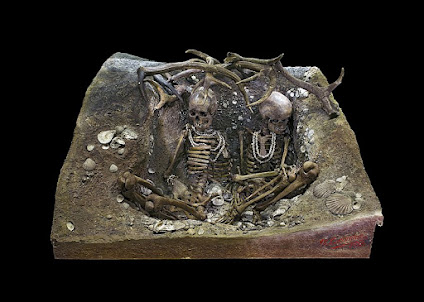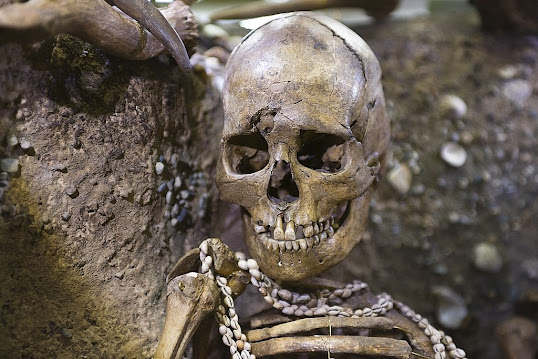What is called the Mesolithic Age | Main features of the Mesolithic
The first information about the Mesolithic period came in 1867 AD. CL Carlyle discovered the small stone tool from the Vindhya region. Which is about 8000 BC to 4000 BC . After this, small stoning discoveries were carried out from different parts of the country. In this way, due to the receipt of stone tools from the large scale and area, it seems that the stone age man lived in a wide area.
Features of the Mesolithic
- The instruments of this period are very small in size.
- Tools range from half an inch to a half inch.
- The main tools of this period are prominent –
- Curved blade, borer, scraper, burin, borer, etc.
- In addition to stone tools, bones and horns have also been found.
- Stone tools have been found made of precious stones like chert, chalcedony, jasper, agate, quartzite, flint.
 |
| Photo Credit-WIKIPEDIA |
“An important thing that came to the fore of this period is that human skeletons are first found in India from the Mesolithic period.”
Major areas associated with the Stone Age in India
The main sites associated with the Mesolithic period in India are Rajasthan, Gujarat, Maharashtra, Andhra Pradesh, Karnataka, Tamil Nadu, Kerala, Madhya Pradesh, Bihar, West Bengal, and Uttar Pradesh.
Rajasthan —- The most prominent Mesolithic site of Rajasthan is ‘Bagore’ located in Bhilwara district. This place was excavated from 1968 to 1970 by VN Mishra. Apart from the Stone Age, Iron Age tools have also been found here.
“Human skeleton has also been found along with stone pelting from Bagore.”
Gujarat — The most prominent place in Gujarat, Langhnaj is the most prominent archaeological site. Here H. D. Sankalia, B. Subbarao, A. R. Kennedy etc. archaeologists got the excavation done.
In addition to small stone tools, animal bones, graveyards and some pottery have also been found from Langhnaj. 14 human skeletons have also been found from here. Most stone tools are made of flake.
Andhra Pradesh —- ‘Nagarjunikonda’ Giddalur and Renigunta are the main sites in Andhra Pradesh from where Mesolithic tools have been found.
Karnataka —- Excavations were done by Subbarao and Sankalia in 1946 and 1969 respectively at a place called ‘Sanganakallu’ located in Bellary district in Karnataka.
A majority of small stone tools have also been found from TERI sites located in Tarunelveli district of Tamil Nadu–Tamil Nadu.
Madhya Pradesh —- About 25 thousand small stone tools were obtained from ‘Adamgarh’ rock shelter located in Hoshangabad district of Madhya Pradesh. Mesolithic tools are found from the rock shelters and caves of ‘Bhimbetka’ located in Raisen district of Madhya Pradesh itself.
These caves were discovered by VS Wakankar in 1958 AD. Evidence of human burial has also been found from these caves.
Bihar —- Many small stone tools are found from the districts of Ranchi, Palamu, Bhagalpur, Rajgir etc. of Bihar province.
West Bengal — Birbhanpur located in Burdwan district of Bengal is a major Mesolithic tool, where excavation work was done by BB Lal on behalf of Archaeological Survey of India from 1954 AD to 1957 AD. About 282 small stone tools have been found from here. These tools have blade, borer, burin, scraper, puncher etc. Dr. Lal has fixed the time of these tools to 4000 BC.
 |
| PHOTO CREDIT- WIKIPEDIA |
Uttar Pradesh – Vindhya region of Uttar Pradesh and upper and middle Ganges valley region is very rich for Mesolithic tools.
Under Vindhya region – Chakia tehsil of Varanasi district, Mirzapur district, Meja, Karchana, and Bara tehsils of Allahabad (Prayagraj) as well as Bundelkhand region are included.
From the Department of Ancient History, Allahabad University.
‘Morhana mountain, Baghhikhor, Lehkhiya located in Mirzapur district’
And ‘Chopanimando’ located in Meja tehsil of Allahabad district, excavations of Mesolithic sites were sold from 1962 to 1980 AD.
Most of the small stone tools as well as male skeletons are found from these places.
17 male skeletons have been found from Lekhiya itself. Most of the heads are in the west direction.
A sequence of development is seen in the small stone tools found from Mirzapur. Equipment has become progressively smaller.
The ‘Chaupanimando’ archaeological site of Allahabad is a vast area spread over fifteen thousand square meters. Most of the stone tools, pebul etc. are found in this entire area. Tools have been made from stones like chert, chalcedony etc.
In addition to the equipment, there is evidence of huts in the excavation here.
Some handmade pottery has also been found.
The period of stone tools among the Chaupanimand has been fixed between 17000-7000 BC.
Apart from Chaupanimand, other famous sites of Allahabad district are Jamunipur (Phulpur tehsil), Kudha, Bichiya, Bhikhpur and Mahrudih (Koron tehsil) from where tools of Mesolithic age have come to light.
 |
| PHPTO CEDIT- WIKIPEDIA |
The small stone tools of Sarainahar are obtuse blades, scrapers, concentric, borer, equilateral and equilateral triangles etc. In whose construction stones have been used like chert, chalcedony, agate, jasper etc.
Site of Damdama (Patti Tehsil)
The archaeological site of Damdama (Patti Tehsil) is situated five kilometers north-west of Mahdaha. Excavation work was done here till 1982-87. Many small stone tools have been found from here like blades, blades, burin, borer, chandrik etc., which have been made from precious stones like quartzite, chert, chalcedony, agate, carnelian etc. Bone and horn tools and ornaments have also been found. Along with this 41 human cremations and some pit stoves have come to light.
Bones of various animals like sheep, goat, cow-ox, buffalo, elephant, rhinoceros, chital reindeer, pig etc. are also found. This proves that the human of this period used to eat the meat of all these animals. The stove would have been used to cook the meat. Pieces of cobwebs, hammers etc. have also been found. The period of the remains found from Damdama has been estimated between 10000 BC to 4000 BC.
Features of the Mesolithic Age
- The life of man of this period was different from that of the pre-stone age.
- Although still humans depended on hunting.
- The people of this period used to hunt cows, bulls, sheep, goats, wild horses, and buffaloes etc.
- During this period man had learned to do some agriculture.
- By the end of this period he had also learned to make utensils.
- Animal husbandry had also started.
- The dead bodies were started to be buried with religious faith.
- While burying the deceased in the tomb, they used to keep food items and tools and weapons with him.
- Therefore, the man of this period had started believing in the extraterrestrial life.
Date of Mesolithic period –
The date of Mesolithic period has been fixed at different places. In many places, it has been fixed till 8000 BC and somewhere till 2000 BC. The Nastaphian culture dates back to around 8000 BC and persisted in Europe and India from 7500 BC to 2000 BC. The Mesolithic industry of South India is estimated to have been dated to 4000 BC. While the date sequence of Adamgarh (Madhya Pradesh) was 5500 BC, Sarai Nahar Rai in Uttar Pradesh started around 7300 BC. In addition, the Mesolithic culture of eastern India has been estimated around 2000 BC.